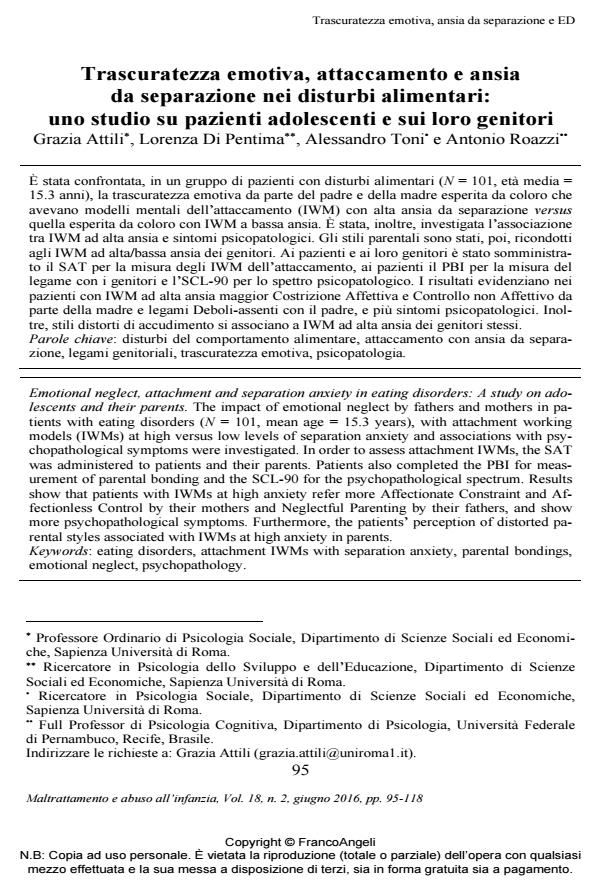Emotional neglect, attachment and separation anxiety in eating disorders: A study on adolescents and their parents
Journal title MALTRATTAMENTO E ABUSO ALL’INFANZIA
Author/s Grazia Attili, Lorenza Di Pentima, Alessandro Toni, Antonio Roazzi
Publishing Year 2016 Issue 2016/2
Language Italian Pages 24 P. 95-118 File size 312 KB
DOI 10.3280/MAL2016-002006
DOI is like a bar code for intellectual property: to have more infomation
click here
Below, you can see the article first page
If you want to buy this article in PDF format, you can do it, following the instructions to buy download credits

FrancoAngeli is member of Publishers International Linking Association, Inc (PILA), a not-for-profit association which run the CrossRef service enabling links to and from online scholarly content.
The impact of emotional neglect by fathers and mothers in patients with eating disorders (N = 101, mean age = 15.3 years), with attachment working models (IWMs) at high versus low levels of separation anxiety and associations with psychopathological symptoms were investigated. In order to assess attachment IWMs, the SAT was administered to patients and their parents. Patients also completed the PBI for measurement of parental bonding and the SCL-90 for the psychopathological spectrum. Results show that patients with IWMs at high anxiety refer more Affectionate Constraint and Affectionless Control by their mothers and Neglectful Parenting by their fathers, and show more psychopathological symptoms. Furthermore, the patients’ perception of distorted parental styles associated with IWMs at high anxiety in parents.
Keywords: Eating disorders, attachment IWMs with separation anxiety, parental bondings, emotional neglect, psychopathology.
- Dysfunctional Parental Care and Emotional Dysregulation: A Pilot Study on the Mediating Role of Attachment Styles and Alexithymia in a Sample of Young Women Lorenza Di Pentima, Alessandro Toni, in Journal of Adult Development /2025
DOI: 10.1007/s10804-025-09523-z - Associations between Adverse Childhood Experiences Subtypes and Eating Disorders: A Systematic Review Marina Angela Visco, Maria Rosaria Juli, Venusia Covelli, Elena Camisasca, in MALTRATTAMENTO E ABUSO ALL'INFANZIA 1/2025 pp.13
DOI: 10.3280/MAL2025-001002 - A letto senza cena. I danni di una strategia educativa fallace sul comportamento alimentare dei minori Carolina Tognon, in MALTRATTAMENTO E ABUSO ALL'INFANZIA 2/2024 pp.97
DOI: 10.3280/MAL2024-002006 - High Anxiety Attachment in Eating Disorders: Intergenerational Transmission by Mothers and Fathers Grazia Attili, Lorenza Di Pentima, Alessandro Toni, Antonio Roazzi, in Paidéia (Ribeirão Preto) /2018
DOI: 10.1590/1982-4327e2813
Grazia Attili, Lorenza Di Pentima, Alessandro Toni, Antonio Roazzi, Trascuratezza emotiva, attaccamento e ansia da separazione nei disturbi alimentari: uno studio su pazienti adolescenti e sui loro genitori in "MALTRATTAMENTO E ABUSO ALL’INFANZIA" 2/2016, pp 95-118, DOI: 10.3280/MAL2016-002006